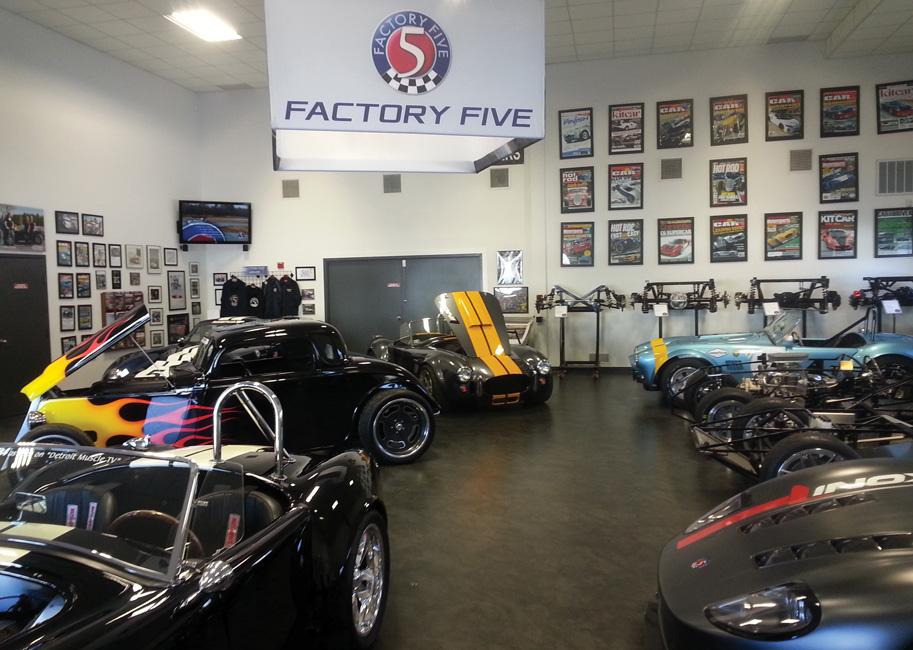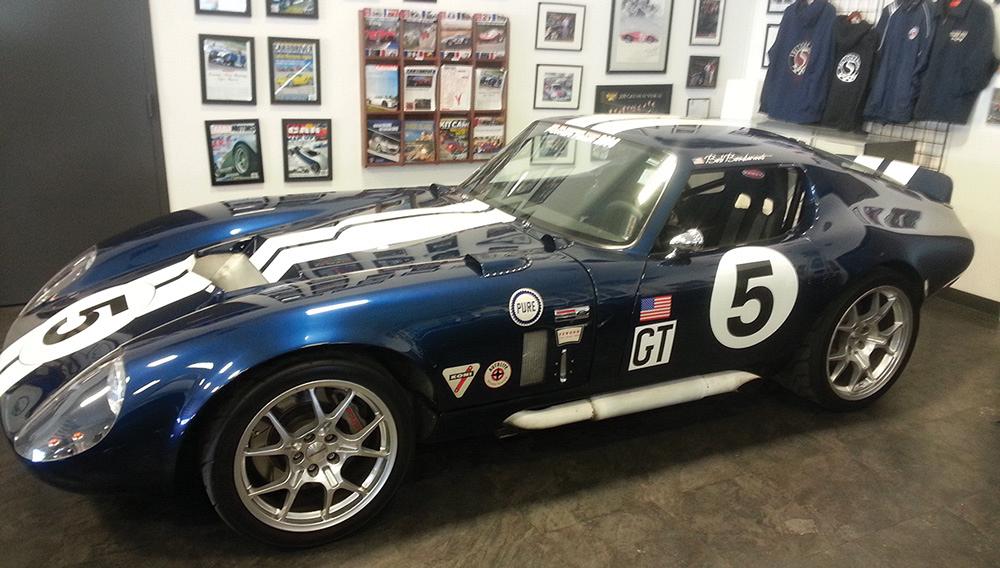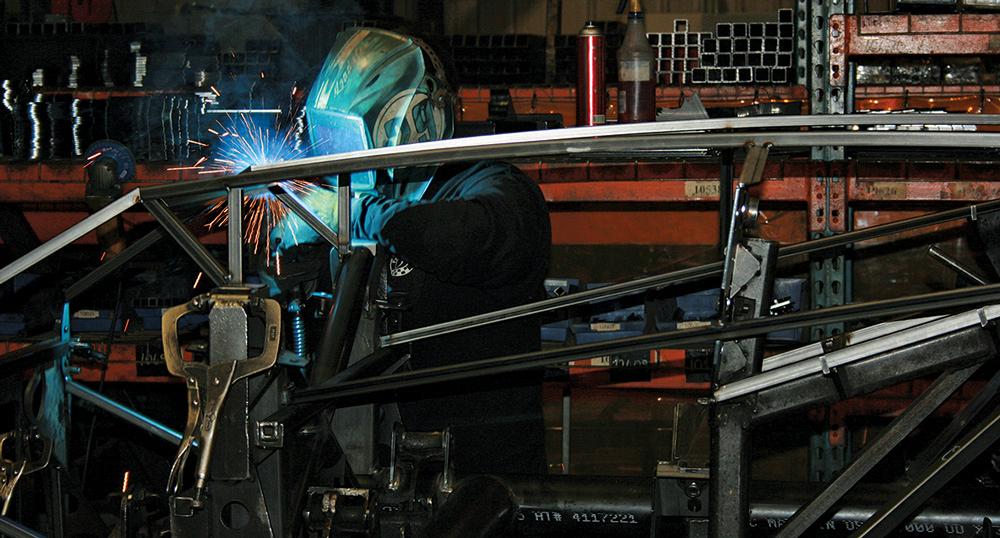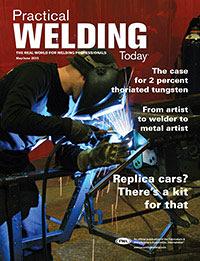- FMA
- The Fabricator
- FABTECH
- Canadian Metalworking
Categories
- Additive Manufacturing
- Aluminum Welding
- Arc Welding
- Assembly and Joining
- Automation and Robotics
- Bending and Forming
- Consumables
- Cutting and Weld Prep
- Electric Vehicles
- En Español
- Finishing
- Hydroforming
- Laser Cutting
- Laser Welding
- Machining
- Manufacturing Software
- Materials Handling
- Metals/Materials
- Oxyfuel Cutting
- Plasma Cutting
- Power Tools
- Punching and Other Holemaking
- Roll Forming
- Safety
- Sawing
- Shearing
- Shop Management
- Testing and Measuring
- Tube and Pipe Fabrication
- Tube and Pipe Production
- Waterjet Cutting
Industry Directory
Webcasts
Podcasts
FAB 40
Advertise
Subscribe
Account Login
Search
Replica cars? There’s a kit for that
Good tools help good people achieve quality, repeatability
- By Amanda Carlson
- May 12, 2015
- Article
- Arc Welding

The showroom at Factory Five Racing, Wareham, Mass., is proof that the component (kit) cars it designs and manufactures are just as much a work of art as anything rolling off the line at high-end auto manufacturers in the U.S., Germany, or Japan. Photos courtesy of Amanda Carlson, associate editor. MayJun15PWT.
Generally speaking, there are two types of car people in the world: those who have the ability to purchase the car or cars of their dreams (think Jay Leno), and then those who relish the act of building their dream car as much as they relish the idea of owning and driving it.
For either the former or the latter, Factory Five Racing, Wareham, Mass., is the world’s largest component (kit) car manufacturer. No, we’re not talking about an equivalent of a do-it-yourself soap box derby car. Instead it is a high-performance, highly designed and engineered automobile that resembles some fairly famous body designs of vehicles that the buyer assembles.
Kit cars are a perfect project for car lovers who enjoy the build as much as they enjoy the finished product. And just an FYI, the finished product rivals that of any high-performance, high-style automobile you might see in the glossy pages of any hot rod magazine.
Essentially, said Nate Johnson, director of operations, Factory Five Racing makes replica cars that are otherwise unobtainable to the person with an average to above-average income.
“We make it so you can build a fun car that is safe, fast, and that actually beats the original in every way, and you don’t feel bad if it gets wet in the rain,” Johnson explained.
Six different kits are available and boast a variety of styles. Some, like the Project 818, come in different versions. Others, like the MK4 Roadster and the Type 65 Coupe, are available as a complete kit or a basic kit.
When a customer purchases the complete kit for the MK4 Roadster, for example, all he is responsible for on his own are the engine, transmission, rear end with rear brakes, wheels and tires, paint, and fuel pump. But a customer who purchases the Basic MK4 Roadster kit is responsible for finding his own driveshaft, spindles/lower A-arms, and radiator/fan shroud, among other things. The idea is to make these cars as affordable as possible for as many people as possible.
It takes about 250 work hours to put together a Factory Five replica automobile—more or less depending on the skill level of the builder. Johnson said the typical customer is the guy who builds out of his garage or home shop on nights after work and on weekends. Some customers are the one-and-done type, while others enjoy the build process so much that they sell the car as soon as it’s complete and purchase a new kit to assemble.
People, Technology, Commitment to Quality
Since opening its doors in 1995, Factory Five Racing has found a way to survive and thrive even during tough economic conditions. Before the recession hit late last decade, the company was churning out 20 to 22 cars a week and had 52 employees. After 2008, however, the company scaled back to about eight cars a week with 30 employees.
Fortunately the rebound for Factory Five came much quicker than anyone had anticipated.

Many cars are available as either a complete or basic kit. The idea is to make these cars as affordable as possible for as many people as possible.
Presently the company manufactures about 15 cars per week. They’ve had to raise their prices slightly, but still feel as though they offer the best bang for your buck. What does that mean? Well, for starters, customers aren’t tasked with performing any cutting or welding during the build process. It is truly a nonfabrication kit.
“With a lot of the early kit cars from the 1970s and 1980s, you had to chop this or that out of a Jaguar or cut the floor panel out of a Volkswagen. Factory Five is not like that at all. We design everything ourselves, and I don’t want you to have to do any welding. We take the liability of all of the welded products. Everything here is made here.”
Change a Wire, Change a Lot
The welding department at Factory Five Racing serves as an integral piece of the puzzle. The company has 10 welding stations where everything is welded manually with gas metal arc welding (GMAW). Roughly 30 to 40 percent of components are welded in a stationary jig before they are moved to a custom-made spin jig for final processing.
Because components are meant to be both structurally sound and visually appealing, every weld must be in place and all spatter removed before the finished part is powder-coated. Chad Gonsalves, welding department manager, has been a welder for the last 14 years, and is in charge of performing quality control on the frames, as well as welding frames and assisting other welders with troubleshooting problems that arise.
About four years ago Factory Five, with the help of Gonsalves, began searching for a different welding wire supplier. At the time its supplier had increased the cost of its wire by almost $2 a pound, and the company felt that increase would, in turn, force them to bump up the price of their cars, which they didn’t want to do.
“We’re going through about $20,000 worth of wire a year. For a small shop we burn a lot of wire,” Gonsalves explained.
After a brief search, the company decided to try the OK AristoRod™ noncopper coated GMAW wire from ESAB Welding & Cutting Products, Florence, S.C. The wire boasted many qualities that were important to the success of the welding department, including smooth welds, low spatter, consistent arc starts, and low fume emission. The price per pound was in line with what the company was looking to spend as well.
Once the wire was in place and in use, Gonsalves found that its Advanced Surface Characteristics (ASC) addressed problems that he had become so accustomed to that he assumed they were normal. After all, with a welding staff that includes a number of young welders, Gonsalves chalked up the problems his guys were having with feeding, arc starts, consistency, and consumables to inexperience.
“Before, we had guys blowing through contact tips,” Gonsalves said.
“Some of the younger guys don’t understand what’s going wrong and it’s just stuff I know from experience. Younger guys might need me to help them fix it. But this wire is something where we can set it and forget it. It really has made a difference for me and how much time I’m spending with the guys helping them fix what the previous wire had caused.”
Johnson isn’t a believer in making his employees, especially the young welders, navigate through equipment-related problems. Instead, he wants to put them on the path to success right off the bat.
“I want them to have the best wire possible. I don’t want them to have to figure out why this thing is spitting, popping, and sticking, or why their liner is breaking all of the time. A lot of times new welders might not understand that the problems they are having with their equipment aren’t their fault. If you give them a good wire, if you give them a good machine, they might be a better welder than they realize."
Gonsalves said the noncopper wire has done just that at a cheaper price and without sacrificing quality.
“The wire flows through the liner so well that you’re getting a much better weld at the end because you’re not getting all of that pulsing and sticking. The smoother wire leads to a smoother weld, in my opinion.”
Lasers: From Headache to Hero
Since day one the Factory Five staff has been committed to employing laser cutting, as they felt it was the only process that could produce the repeatable and precise quality they needed for components. This was especially forward-thinking at a time when many of Factory Five’s competitors were cutting their parts with plasma or band saw or jigsaw technology.
“We wanted to make sure that we could reproduce the same part over and over again. We’re not in the business of making these one-off snowflake cars,” Johnson said.
For more than a decade Factory Five contracted out all of its laser cutting work with a local firm. But approximately three years ago, Johnson said they decided to vertically integrate the business, and the first plausible step was to stop outsourcing its laser cutting work and instead bring that capability in-house.
This would help the company cut parts based on its own schedules, and it would also allow it to make changes quickly to components with minimal wait time. By relying on a laser cutting contractor, the company would have to send a design out, pay a rush fee to expedite shipping, and wait a week or a week and a half for the parts to be completed and shipped back. And it never failed that once the parts were bolted up, they’d find that things weren’t quite right and would have to repeat the process. For a company that is so focused on quality and repeatability, not having total control of its parts or total ability to make changes quickly was difficult.
Johnson said they evaluated three or four different laser equipment suppliers before deciding on a fiber laser. That, Johnson said, was the beginning of six months of hell.
Programming was difficult, which made operating the machine a challenge. These struggles led to falling behind on production, mistakes and scrapped parts, and a lot of agonizing by the laser operator.

Nate Johnson, director of operations, has spent his entire working life (18 years) at Factory Five Racing. It’s truly a family company where people care just as much about each other as they do about putting out a quality product.
“He had a nightmare of a time with it. Six months of just fighting with this thing and it had nothing to do with the operator. We had to go back to our laser cutter that we had contracted with hat in hand,” Johnson explained.
What made matters worse, Johnson said, was finding out they were one of the beta testers of this particular fiber laser.
“They pretty much lied to us and told us that there were tons of these machines out in shops, when there weren’t.”
Frustrated but not deterred, they removed the existing laser and began their search once again.
This time the company selected a 3015 LVPlus II-35CF-R, a CO2 laser that’s part of Mitsubishi Laser’s LV series.
Johnson described the machine as the “Chevy 350” of the lasers. He said the fact that this machine has been in the marketplace for more than a decade and that there are over 1,000 in shops around the globe was comforting to hear after the traumatic experience with their previous laser.
“I don’t want to reinvent the wheel here, I just want something that works.”
Roughly eight days after he placed the order, the laser arrived to the shop. Two weeks after that the machine was in full operation. Even though the company needs the machine to run only about 30 hours a week, the laser has already provided dividends in time and money, and the return on investment took only 18 months.
Now, instead of a back-and-forth process that would take weeks, Factory Five’s laser operator works directly with the lead engineer to achieve the desired part within a three-hour period.
Factory Five Racing, 9 Tow Road, Wareham, MA 02571, 508-291-3443, www.factoryfive.com
About the Author

Amanda Carlson
2135 Point Blvd
Elgin, IL 60123
815-227-8260
Amanda Carlson was named as the editor for The WELDER in January 2017. She is responsible for coordinating and writing or editing all of the magazine’s editorial content. Before joining The WELDER, Amanda was a news editor for two years, coordinating and editing all product and industry news items for several publications and thefabricator.com.
About the Publication
subscribe now

The Welder, formerly known as Practical Welding Today, is a showcase of the real people who make the products we use and work with every day. This magazine has served the welding community in North America well for more than 20 years.
start your free subscription- Stay connected from anywhere

Easily access valuable industry resources now with full access to the digital edition of The Fabricator.

Easily access valuable industry resources now with full access to the digital edition of The Welder.

Easily access valuable industry resources now with full access to the digital edition of The Tube and Pipe Journal.
- Podcasting
- Podcast:
- The Fabricator Podcast
- Published:
- 04/16/2024
- Running Time:
- 63:29
In this episode of The Fabricator Podcast, Caleb Chamberlain, co-founder and CEO of OSH Cut, discusses his company’s...
- Industry Events
16th Annual Safety Conference
- April 30 - May 1, 2024
- Elgin,
Pipe and Tube Conference
- May 21 - 22, 2024
- Omaha, NE
World-Class Roll Forming Workshop
- June 5 - 6, 2024
- Louisville, KY
Advanced Laser Application Workshop
- June 25 - 27, 2024
- Novi, MI

































